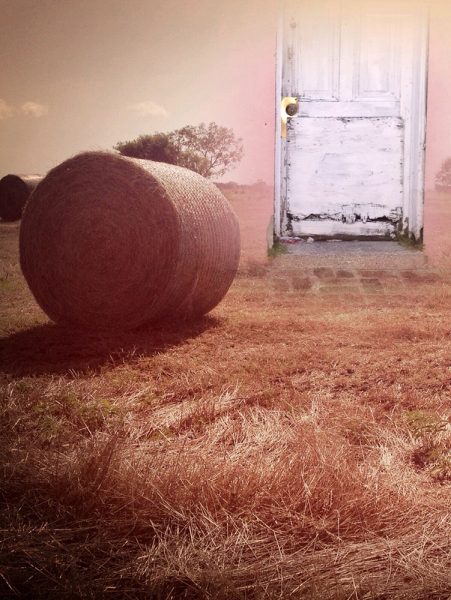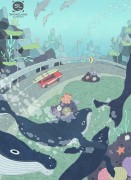I love the precision of the architectural details and the setting as a whole; I’m reminded of those cross-sectional shots in a Wes Anderson film where you see action in all corners of the frame (Amelia and Nick reading together, but apart). When the tree makes its entrance—“wood upon wood and all wrong”—it’s a real upsetting of the meticulously depicted (if half-finished) interior. Can you tell us more about how setting works in your writing, at least for “The Nest”?
I love rich description—imagery that evokes history and character, that grounds us in a place and helps establish the stakes of a story. I wanted Amelia and Nick’s house to be both distinctive and familiar, an unfinished space they are each bound to and that may or may not become the house of their dreams, the backdrop for the life they once imagined. I have been thinking a lot about how a few choice details can help bring a character—or a room—to life; if we see several components of a landscape we can often fill in the rest. In my favorite stories, the descriptive language brings its own charge, making us more alive to the world we are navigating, its vitality and its capacity for drama and surprise.
One of the challenging things about writing flash fiction is hinting at a larger context for your characters—their lives outside the frame—and simultaneously focusing on just a little piece of the canvas. It’s something you balance wonderfully in this story. Did you first imagine Nick and Amelia’s biographies, or just fill in the details later?
I knew I wanted to write about a young marriage at a crossroads. I wasn’t sure at first what would lead to Nick and Amelia living on different floors of their house—or what would happen to them in the space of the story. But I saw each of them, their pasts and their shared past, the enormous weight of the future. At some point in the drafting process, it occurred to me that they have lost a child—that Amelia has had a miscarriage—and the loss has driven them apart, or contributed to the fallout. This gave their plans for the house, the blood on Amelia’s hands and legs from the shattered glass, the nest and the eggs Amelia imagines, “the yolky heartbeats that could be saved,” a deeper resonance as I wrote. But I wanted this backstory to be subtle and offstage, so the reader might piece it together or might just sense its magnitude behind the unraveling.
“Write past the ending” is a common piece of writing advice (and so is its opposite), but your story begins with the aftermath. How did you decide to begin there?
I saw the house as a beloved project—a vision for the future, a possible money pit—that has become a war zone, with two distinct territories and wreckage in between. I wanted something to happen that would threaten Amelia and Nick’s standoff. The falling tree seemed like a good vehicle for bringing them together—for an end that might well be a new beginning.
As a former editor for Random House, MacAdam/Cage, and Ballantine, among others, you’re more than a little familiar with the slush pile—I read how you pulled Audrey Niffenegger’s The Time Traveler’s Wife out of one! What’s it like to be on the other end of things?
It is humbling and exhilarating. I know the thrill of a promising cover letter and the deepening thrill of a strong manuscript—the clarity and authority, sparkle and pull that make an early reader believe they are in good writerly hands, even when holding a stack of pages in Times New Roman. Generating that thrill (and the magic beyond) is certainly something to shoot for.
How does your work in the publishing industry inform your own writing? Does it feel like you’re approaching writing from a different angle than, say, your MFA classmates?
For the most part, I have to turn away from what I know about the industry—except the heart of it: the passionate readers who work in every corner, and what can happen when everything aligns. But not thinking like an editor is harder. I am learning how to trust my own decisions—even if they end up evolving or being overturned in later drafts—and how to plan less and write more.
The best thing you’ve read in the past 12 months and why? (And feel free to choose more than one, which is almost always the case.)
I loved Karen E. Bender’s Refund. The stories are psychologically rich, with a masterful proportion of description, backstory, and propulsive narration: I was moved, impressed, and deeply curious about where I would be taken—in the best way, it felt like it could be anywhere.
I couldn’t stop talking about Lauren Groff’s “The Midnight Zone,” which the New Yorker published in May. It’s such a haunting depiction of motherhood; a literary horror story riddled with tenderness and regret.
And when I read Sherman Alexie’s “What You Pawn I Will Redeem” (published in the New Yorker in 2003) I couldn’t believe it had taken me so long to find it. What a feat of voice! It’s so poignant, so funny and transporting, it would have been remarkable even if it weren’t so beautifully engineered—but it is that, too.



 The core workshop of SmokeLong Fitness is all in writing, so you can take part from anywhere at anytime. We are excited about creating a supportive, consistent and structured environment for flash writers to work on their craft in a community. We are thrilled and proud to say that our workshop participants have won, placed, or been listed in every major flash competition. Community works.
The core workshop of SmokeLong Fitness is all in writing, so you can take part from anywhere at anytime. We are excited about creating a supportive, consistent and structured environment for flash writers to work on their craft in a community. We are thrilled and proud to say that our workshop participants have won, placed, or been listed in every major flash competition. Community works.